+ Open data
Open data
- Basic information
Basic information
| Entry | Database: PDB / ID: 6axz | ||||||
|---|---|---|---|---|---|---|---|
| Title | Segment from bank vole prion protein 168-176 QYNNQNNFV | ||||||
 Components Components | Major prion protein | ||||||
 Keywords Keywords | PROTEIN FIBRIL / polar clasp / amyloid fibril / prion | ||||||
| Function / homology |  Function and homology information Function and homology informationside of membrane / protein homooligomerization / Golgi apparatus / metal ion binding / plasma membrane Similarity search - Function | ||||||
| Biological species |  Myodes glareolus (Bank vole) Myodes glareolus (Bank vole) | ||||||
| Method | ELECTRON CRYSTALLOGRAPHY / electron crystallography / AB INITIO PHASING / cryo EM / Resolution: 0.75 Å | ||||||
| Model details | polar clasp, MicroED, Glutamine ladder, Asparagine ladder | ||||||
 Authors Authors | Glynn, C. / Rodriguez, J.A. / Boyer, D.R. / Gallagher-Jones, M. | ||||||
 Citation Citation |  Journal: Nat Struct Mol Biol / Year: 2018 Journal: Nat Struct Mol Biol / Year: 2018Title: Sub-ångström cryo-EM structure of a prion protofibril reveals a polar clasp. Authors: Marcus Gallagher-Jones / Calina Glynn / David R Boyer / Michael W Martynowycz / Evelyn Hernandez / Jennifer Miao / Chih-Te Zee / Irina V Novikova / Lukasz Goldschmidt / Heather T McFarlane / ...Authors: Marcus Gallagher-Jones / Calina Glynn / David R Boyer / Michael W Martynowycz / Evelyn Hernandez / Jennifer Miao / Chih-Te Zee / Irina V Novikova / Lukasz Goldschmidt / Heather T McFarlane / Gustavo F Helguera / James E Evans / Michael R Sawaya / Duilio Cascio / David S Eisenberg / Tamir Gonen / Jose A Rodriguez /   Abstract: The atomic structure of the infectious, protease-resistant, β-sheet-rich and fibrillar mammalian prion remains unknown. Through the cryo-EM method MicroED, we reveal the sub-ångström-resolution ...The atomic structure of the infectious, protease-resistant, β-sheet-rich and fibrillar mammalian prion remains unknown. Through the cryo-EM method MicroED, we reveal the sub-ångström-resolution structure of a protofibril formed by a wild-type segment from the β2-α2 loop of the bank vole prion protein. The structure of this protofibril reveals a stabilizing network of hydrogen bonds that link polar zippers within a sheet, producing motifs we have named 'polar clasps'. | ||||||
| History |
|
- Structure visualization
Structure visualization
| Movie |
 Movie viewer Movie viewer |
|---|---|
| Structure viewer | Molecule:  Molmil Molmil Jmol/JSmol Jmol/JSmol |
- Downloads & links
Downloads & links
- Download
Download
| PDBx/mmCIF format |  6axz.cif.gz 6axz.cif.gz | 15.5 KB | Display |  PDBx/mmCIF format PDBx/mmCIF format |
|---|---|---|---|---|
| PDB format |  pdb6axz.ent.gz pdb6axz.ent.gz | 8.1 KB | Display |  PDB format PDB format |
| PDBx/mmJSON format |  6axz.json.gz 6axz.json.gz | Tree view |  PDBx/mmJSON format PDBx/mmJSON format | |
| Others |  Other downloads Other downloads |
-Validation report
| Summary document |  6axz_validation.pdf.gz 6axz_validation.pdf.gz | 310.2 KB | Display |  wwPDB validaton report wwPDB validaton report |
|---|---|---|---|---|
| Full document |  6axz_full_validation.pdf.gz 6axz_full_validation.pdf.gz | 309.7 KB | Display | |
| Data in XML |  6axz_validation.xml.gz 6axz_validation.xml.gz | 1.3 KB | Display | |
| Data in CIF |  6axz_validation.cif.gz 6axz_validation.cif.gz | 1.7 KB | Display | |
| Arichive directory |  https://data.pdbj.org/pub/pdb/validation_reports/ax/6axz https://data.pdbj.org/pub/pdb/validation_reports/ax/6axz ftp://data.pdbj.org/pub/pdb/validation_reports/ax/6axz ftp://data.pdbj.org/pub/pdb/validation_reports/ax/6axz | HTTPS FTP |
-Related structure data
| Related structure data |  7017MC  7287C  6btkC M: map data used to model this data C: citing same article ( |
|---|---|
| Similar structure data |
- Links
Links
- Assembly
Assembly
| Deposited unit | 
| ||||||||
|---|---|---|---|---|---|---|---|---|---|
| 1 | 
| ||||||||
| Unit cell |
|
- Components
Components
| #1: Protein/peptide | Mass: 1140.162 Da / Num. of mol.: 1 / Fragment: UNP residues 168-176 / Source method: obtained synthetically / Source: (synth.)  Myodes glareolus (Bank vole) / References: UniProt: Q8VHV5 Myodes glareolus (Bank vole) / References: UniProt: Q8VHV5 |
|---|---|
| #2: Water | ChemComp-HOH / |
-Experimental details
-Experiment
| Experiment | Method: ELECTRON CRYSTALLOGRAPHY / Number of used crystals: 1 |
|---|---|
| EM experiment | Aggregation state: 3D ARRAY / 3D reconstruction method: electron crystallography |
- Sample preparation
Sample preparation
| Component | Name: bank vole prion 168-176 / Type: COMPLEX / Entity ID: #1 / Source: NATURAL |
|---|---|
| Molecular weight | Value: 0.0046 MDa / Experimental value: YES |
| Source (natural) | Organism:  Myodes glareolus (Bank vole) Myodes glareolus (Bank vole) |
| Buffer solution | pH: 6 |
| Specimen | Embedding applied: NO / Shadowing applied: NO / Staining applied: NO / Vitrification applied: YES |
| Vitrification | Cryogen name: ETHANE |
| Crystal grow | Temperature: 298 K / Method: batch mode / pH: 6 / Details: 10% MPD, 0.1 M MES, pH 6.0 |
-Data collection
| Experimental equipment |  Model: Tecnai F20 / Image courtesy: FEI Company | ||||||||||||||||||||||||||||||||||||||||||||||||||||||||||||||||||||||||||||||||||||||||||||||||||||||||||||||||||||||||||||||||||||||||||||||||||||||||||||||||||||||||||||||||||||||||||||||||||||||||||||||||||
|---|---|---|---|---|---|---|---|---|---|---|---|---|---|---|---|---|---|---|---|---|---|---|---|---|---|---|---|---|---|---|---|---|---|---|---|---|---|---|---|---|---|---|---|---|---|---|---|---|---|---|---|---|---|---|---|---|---|---|---|---|---|---|---|---|---|---|---|---|---|---|---|---|---|---|---|---|---|---|---|---|---|---|---|---|---|---|---|---|---|---|---|---|---|---|---|---|---|---|---|---|---|---|---|---|---|---|---|---|---|---|---|---|---|---|---|---|---|---|---|---|---|---|---|---|---|---|---|---|---|---|---|---|---|---|---|---|---|---|---|---|---|---|---|---|---|---|---|---|---|---|---|---|---|---|---|---|---|---|---|---|---|---|---|---|---|---|---|---|---|---|---|---|---|---|---|---|---|---|---|---|---|---|---|---|---|---|---|---|---|---|---|---|---|---|---|---|---|---|---|---|---|---|---|---|---|---|---|---|---|---|---|
| Microscopy | Model: FEI TECNAI F20 | ||||||||||||||||||||||||||||||||||||||||||||||||||||||||||||||||||||||||||||||||||||||||||||||||||||||||||||||||||||||||||||||||||||||||||||||||||||||||||||||||||||||||||||||||||||||||||||||||||||||||||||||||||
| Electron gun | Electron source:  FIELD EMISSION GUN / Accelerating voltage: 200 kV / Illumination mode: FLOOD BEAM FIELD EMISSION GUN / Accelerating voltage: 200 kV / Illumination mode: FLOOD BEAM | ||||||||||||||||||||||||||||||||||||||||||||||||||||||||||||||||||||||||||||||||||||||||||||||||||||||||||||||||||||||||||||||||||||||||||||||||||||||||||||||||||||||||||||||||||||||||||||||||||||||||||||||||||
| Electron lens | Mode: DIFFRACTION | ||||||||||||||||||||||||||||||||||||||||||||||||||||||||||||||||||||||||||||||||||||||||||||||||||||||||||||||||||||||||||||||||||||||||||||||||||||||||||||||||||||||||||||||||||||||||||||||||||||||||||||||||||
| Image recording | Electron dose: 0.025 e/Å2 / Film or detector model: TVIPS TEMCAM-F416 (4k x 4k) | ||||||||||||||||||||||||||||||||||||||||||||||||||||||||||||||||||||||||||||||||||||||||||||||||||||||||||||||||||||||||||||||||||||||||||||||||||||||||||||||||||||||||||||||||||||||||||||||||||||||||||||||||||
| EM diffraction | Camera length: 950 mm | ||||||||||||||||||||||||||||||||||||||||||||||||||||||||||||||||||||||||||||||||||||||||||||||||||||||||||||||||||||||||||||||||||||||||||||||||||||||||||||||||||||||||||||||||||||||||||||||||||||||||||||||||||
| EM diffraction shell | Resolution: 0.75→0.77 Å / Fourier space coverage: 96.2 % / Multiplicity: 4.4 / Num. of structure factors: 532 / Phase residual: 0.01 ° | ||||||||||||||||||||||||||||||||||||||||||||||||||||||||||||||||||||||||||||||||||||||||||||||||||||||||||||||||||||||||||||||||||||||||||||||||||||||||||||||||||||||||||||||||||||||||||||||||||||||||||||||||||
| EM diffraction stats | Fourier space coverage: 97.1 % / High resolution: 0.75 Å / Num. of intensities measured: 43252 / Num. of structure factors: 7474 / Phase error: 0.01 ° / Phase residual: 0.01 ° / Phase error rejection criteria: 0 / Rmerge: 23.2 / Rsym: 23.2 | ||||||||||||||||||||||||||||||||||||||||||||||||||||||||||||||||||||||||||||||||||||||||||||||||||||||||||||||||||||||||||||||||||||||||||||||||||||||||||||||||||||||||||||||||||||||||||||||||||||||||||||||||||
| Diffraction | Mean temperature: 100 K | ||||||||||||||||||||||||||||||||||||||||||||||||||||||||||||||||||||||||||||||||||||||||||||||||||||||||||||||||||||||||||||||||||||||||||||||||||||||||||||||||||||||||||||||||||||||||||||||||||||||||||||||||||
| Radiation | Protocol: SINGLE WAVELENGTH / Monochromatic (M) / Laue (L): M / Scattering type: electron | ||||||||||||||||||||||||||||||||||||||||||||||||||||||||||||||||||||||||||||||||||||||||||||||||||||||||||||||||||||||||||||||||||||||||||||||||||||||||||||||||||||||||||||||||||||||||||||||||||||||||||||||||||
| Radiation wavelength | Relative weight: 1 | ||||||||||||||||||||||||||||||||||||||||||||||||||||||||||||||||||||||||||||||||||||||||||||||||||||||||||||||||||||||||||||||||||||||||||||||||||||||||||||||||||||||||||||||||||||||||||||||||||||||||||||||||||
| Reflection | Resolution: 0.75→10.338 Å / Num. obs: 7474 / % possible obs: 97.1 % / Observed criterion σ(I): -3 / Redundancy: 5.787 % / Biso Wilson estimate: 4.17 Å2 / CC1/2: 0.982 / Rmerge(I) obs: 0.232 / Rrim(I) all: 0.25 / Χ2: 0.872 / Net I/σ(I): 4.57 / Num. measured all: 43252 / Scaling rejects: 7 | ||||||||||||||||||||||||||||||||||||||||||||||||||||||||||||||||||||||||||||||||||||||||||||||||||||||||||||||||||||||||||||||||||||||||||||||||||||||||||||||||||||||||||||||||||||||||||||||||||||||||||||||||||
| Reflection shell | Diffraction-ID: 1
|
- Processing
Processing
| Software |
| ||||||||||||||||||||||||||||||||||||||||||
|---|---|---|---|---|---|---|---|---|---|---|---|---|---|---|---|---|---|---|---|---|---|---|---|---|---|---|---|---|---|---|---|---|---|---|---|---|---|---|---|---|---|---|---|
| EM software | Name:  Coot / Category: model refinement Coot / Category: model refinement | ||||||||||||||||||||||||||||||||||||||||||
| EM 3D crystal entity | ∠α: 94.21 ° / ∠β: 92.38 ° / ∠γ: 102.2 ° / A: 4.94 Å / B: 10.34 Å / C: 31.15 Å / Space group name: P1 / Space group num: 1 | ||||||||||||||||||||||||||||||||||||||||||
| CTF correction | Type: NONE | ||||||||||||||||||||||||||||||||||||||||||
| 3D reconstruction | Resolution method: DIFFRACTION PATTERN/LAYERLINES / Symmetry type: 3D CRYSTAL | ||||||||||||||||||||||||||||||||||||||||||
| Atomic model building | B value: 6.068 / Protocol: AB INITIO MODEL / Space: RECIPROCAL / Target criteria: maximum likelihood | ||||||||||||||||||||||||||||||||||||||||||
| Refinement | Method to determine structure: AB INITIO PHASING / Resolution: 0.75→10.338 Å / SU ML: 0.15 / Cross valid method: FREE R-VALUE / σ(F): 1.95 / Phase error: 36.9 / Stereochemistry target values: ML
| ||||||||||||||||||||||||||||||||||||||||||
| Solvent computation | Shrinkage radii: 0.9 Å / VDW probe radii: 1.11 Å / Solvent model: FLAT BULK SOLVENT MODEL | ||||||||||||||||||||||||||||||||||||||||||
| Displacement parameters | Biso max: 17.71 Å2 / Biso mean: 6.0686 Å2 / Biso min: 1.29 Å2 | ||||||||||||||||||||||||||||||||||||||||||
| Refine LS restraints |
| ||||||||||||||||||||||||||||||||||||||||||
| LS refinement shell | Refine-ID: ELECTRON CRYSTALLOGRAPHY / Rfactor Rfree error: 0 / Total num. of bins used: 5
|
 Movie
Movie Controller
Controller



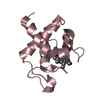


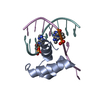

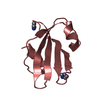

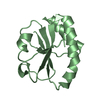

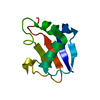
 PDBj
PDBj


